|

Crisp and Incisive
English Touring Opera's 'Magic Flute',
enjoyed by ROBERT HUGILL
For a production of The Magic Flute to really succeed it needs to address the work's multifarious nature, capturing both its moral seriousness and its fun. The Magic Flute is an opera with great range both in terms of dramatic situation and music-dramatic styles. It is also not without problems. For instance, how relevant are the Masonic references today; is it possible to fully appreciate Mozart's Masonic music at the opening of Act 2 without explicit Masonic references? And then there is what might be termed the 'Bernard Manning' elements, the racism and misogyny present in the libretto.
English Touring Opera has opened its 30th Anniversary year with a new production of The Magic Flute (seen Saturday 14 March 2009 at the Hackney Empire, London UK), directed by Liam Steel. This used Jeremy Sams' English version of the libretto, which tidied things up somewhat. Monostatos (Andrew Friedhoff) was dark faced, though it was either a disguise or dirt and certainly not an attempt to go black faced, but no mention was made of his colour in the text. This rather weakened his first encounter with Papageno (Daniel Grice), whose own bird-ness was played down. The misogynistic elements were left in, albeit rather watered down, but then without them the plot makes even less sense than usual.
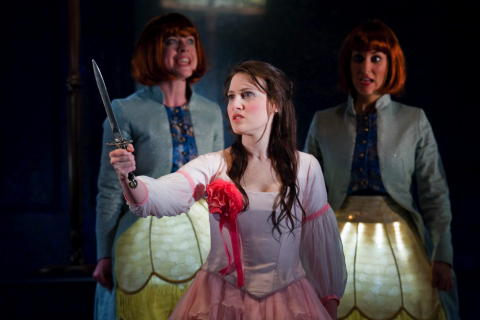
Paula Sides as Pamina (centre) in English Touring Opera's 'Magic Flute'. Photo © 2009 Robert Workman
|
Liam Steel is a choreographer who has directed operas for ETO before. His approach is very physical and he used the chorus rather more than might be expected. The only real weakness of the production, if weakness it was, was that it used a single set (designed by Chloe Lamford), an eighteenth century style room on three levels with three pairs of doors and an aperture at the back which formed either a screen (for videos) or a frame for entrances. The set itself was enormously versatile, especially combined with Guy Hoare's lighting and videos from Matt Spencer. But using a single set meant that the domain of Sarastro (Andrew Slater) seemed rather too similar to that of the Queen of the Night (Laure Melroy). This led you to wonder whether the entire event might not be a figment of Tamino's imagination. A thought which was strengthened by the way Steel staged the opening.
At the end of the overture the chorus, dressed in modern formal party clothes, presented a series of tableaux depicting an extremely lively party, with Tamino (Mark Wilde) wandering through apparently in search of someone. The serpent from which the three ladies 'saved' him was a serpent of people, as if Tamino needed rescuing from his fears of society. But this concept was not overly pressed and might simply have been an imaginative and inexpensive way of dealing with the problem of the serpent. At least Steel gave us something which made us think rather than the risible property serpent of many productions.
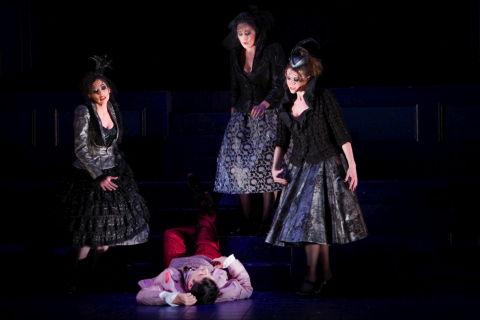
Mark Wilde as Tamino with three ladies in attendance, in English Touring Opera's 'Magic Flute'. Photo © 2009 Robert Workman
|
The three ladies (Cheryl Enever, Patricia Orr, Niamh Kelly) were strong and balanced vocally, they managed to be amusing and not a little bit threatening. Like many of the smaller roles, they were drawn from ETO's hard working chorus. Chloe Lamford's costumes were classic rather than evoking a particular era. The three ladies looked rather 1950s, but Tamino's long formal coat seemed a twentieth century reworking of the eighteenth century (something carried over to Sarastro and Pamina as well).
Mark Wilde's Tamino was relatively light voiced, but he phrased robustly and displayed a remarkable degree of strength and stamina. Whilst never sounding heroic, Wilde convinced as a hero who grew in stature as the opera progressed. His performance of his first aria was especially notable.
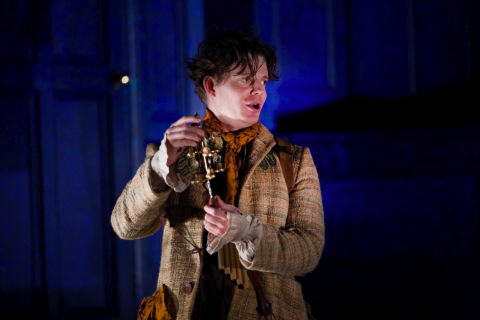
Daniel Grice as Papageno in English Touring Opera's 'Magic Flute'. Photo © 2009 Robert Workman
|
Daniel Grice's Papageno, dressed as a game keeper, entered surrounded by birds which were articulated by members of the chorus. Grice's Papageno was easy of manner and voice. You never felt he was ever addressing the audience directly in that way that many major Papagenos have done, and this is something he might develop. But he was lively and personable in the role, combining this with some finely musical singing. The use of Jeremy Sams' rather colloquial translation meant that in dialogue Papageno stood out rather less than might happen in a more traditionally hierarchical version.
Laure Melroy's Queen of the Night made a notable entrance from the rear, her shining blue cloak filling the stage, articulated in billows by unseen hands from under the stage. Melroy's account of both the Queen's arias was virtuoso with a strong upper register, but Melroy is no mere canary and her Queen was both vivid and virulent, a bit scary from the beginning.
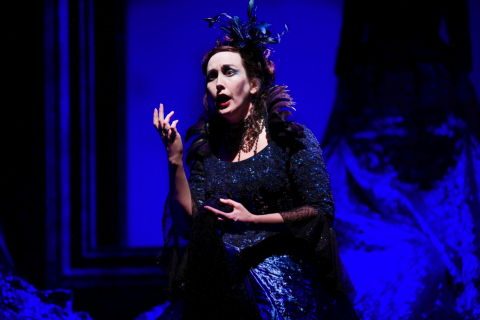
Laure Meloy as Queen of the Night in English Touring Opera's 'Magic Flute'. Photo © 2009 Robert Workman
|
The production was quite prop heavy and Steel made good use of the traps in the stage, with items being passed up by unseen hands. I was impressed by how the production was neatly and thoroughly thought through and carefully plotted.
Andrew Friedhoff's Monostatos wasn't a moor but more simply a ruffian, which only serves to add an extra puzzlement to the plot; why does Sarastro tolerate this man? Friedhoff had a strong, forward, slightly nasal voice which made an impressive effect combined with his threatening demeanour.
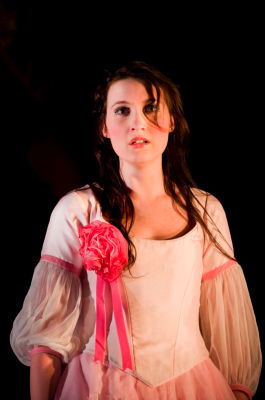
Paula Sides as Pamina in English Touring Opera's 'Magic Flute'. Photo © 2009 Robert Workman
|
Paula Sides' Pamina was strong in voice and will, she was no shrinking violet but an equal helpmeet to Tamino. Her account of Pamina's arias was robustly phrased but still touching.
The animals which Tamino subdued with his flute were again the party goers from the opening, this time with animal attributes, giving us another hint of Steel's underlying theme.
Sarastro's supporters, when they arrived, were dressed soberly in long white tunics, but Sarastro himself (Andrew Slater) wore an amazing glittering coat, the light complement to the Queen of the Night's dark.
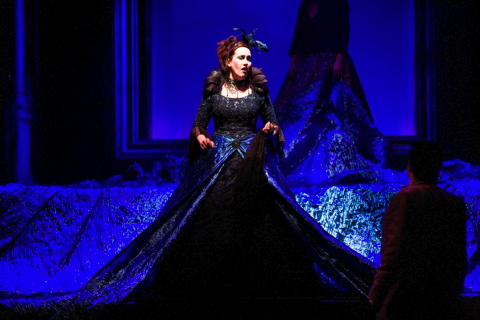
Laure Meloy as Queen of the Night in English Touring Opera's 'Magic Flute'. Photo © 2009 Robert Workman
|
As a choreographer as well as director Steel gave the chorus plenty to do. Act 2 opened with an elaborate set piece for the men all carrying curious light sabres. The eight men of the chorus made a lovely rich sound and impressed in Mozart's male-voiced choruses.
Andrew Slater's Sarastro had an impressive bearing with the physique du rôle, his voice sounded more like that of a baritone with a lower extension, he had all the notes but his lower voice lacked the darkness which is ideal in this role.
Inevitably in such a small budget production Tamino's trials were understated, though good use was made of video. Elsewhere Steel was enormously inventive; Papageno's creation of his ideal woman out of lamp shades was one particularly notable moment. This use of light was a recurrent theme. The three boys (Anne-Marie Cullum, Heather Longman, Melanie Lang) wore lit lamp shades round their waists; and Sarastro's followers used a variety of lit implements in addition to the light sabres.
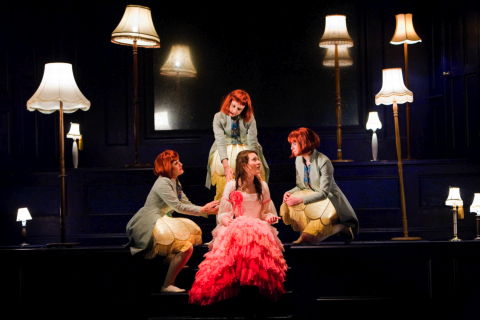
Paula Sides as Pamina (lower centre) with the three boys in English Touring Opera's 'Magic Flute'. Photo © 2009 Robert Workman
|
All of the smaller roles were very strongly cast, with Ronald Nairne as the Speaker, Robert Davies and Blake Fischer as Priests, Charne Rochford and Piotr Lempa as Armed Men and Emily Rowley Jones as Papagena. This large and hard-working cast, under the musical direction of Paul McGrath ensured that we got a strong, well-balanced musical performance. They have developed into a fine ensemble, with no weak points.
Diction was excellent, so that we scarcely needed the surtitles and in fact they were a little distracting at times. Even Laure Melroy, as the Queen of the Night, managed a remarkable amount of text in her arias. The dialogue was similarly well projected with only a couple of weak points. Melroy's spoken dialogue seemed to lack the virulence which she brought to her vocal performance.
The orchestra, under Paul McGrath's direction, gave a crisp and incisive account of the score. Inevitably, with a relatively small band, the sound was not as expansive as with a bigger ensemble. But McGrath and his players made a virtue of this necessity and gave us a performance notable for its litheness and responsiveness.
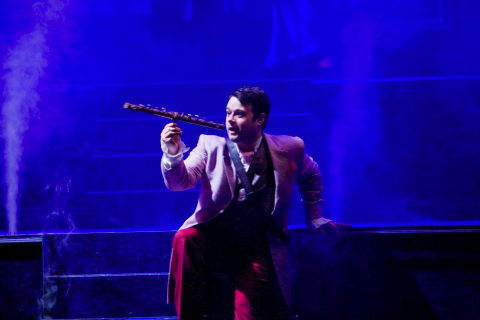
Mark Wilde as Tamino in English Touring Opera's 'Magic Flute'. Photo © 2009 Robert Workman
|
Occasionally in the past I have felt that ETO's productions seemed to be designed for the exigencies of touring and did not quite fill the Hackney Empire. On this occasion they filled the theatre admirably, giving us an account of the opera which was strong on sense and fun, but light on gimmickry.
Copyright © 18 March 2009
Robert Hugill, London UK

| 
